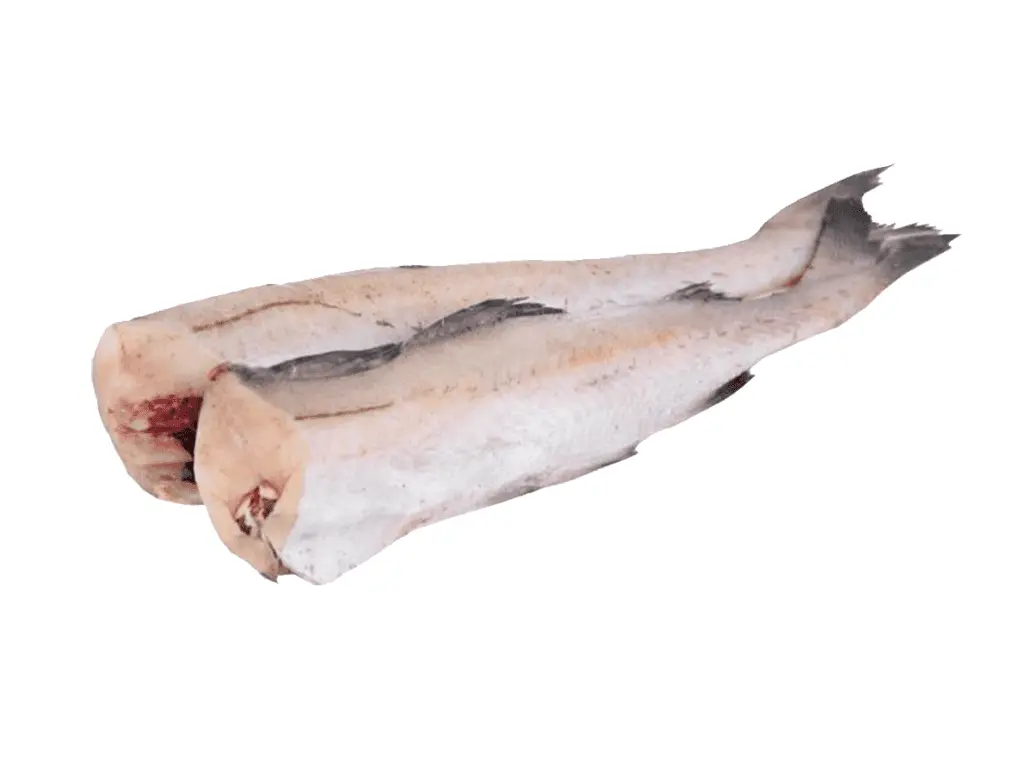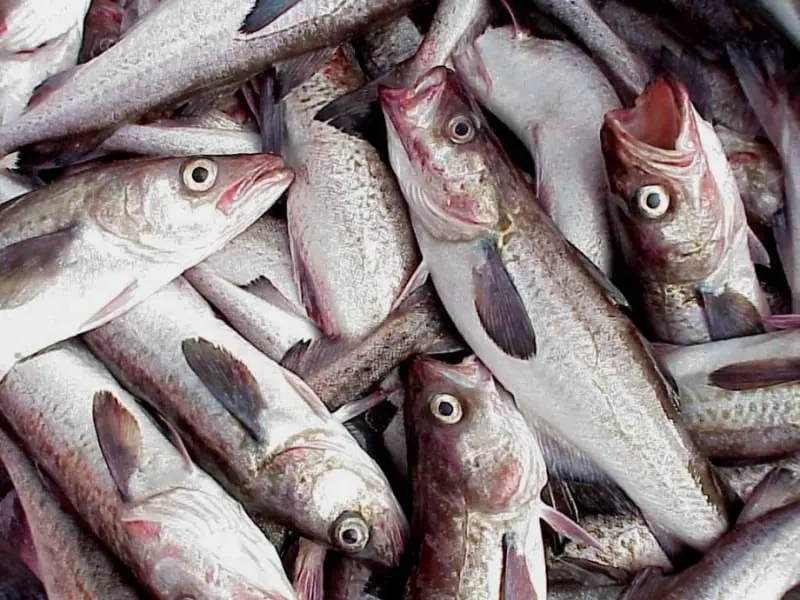Contents
Pollock (Latin name Theragra chalcogramma, international name Alaska pollock) is a bottom-pelagic cold-loving fish of the cod family. It is most common in the North Pacific Ocean (Bering Sea, Alaska Bay, Monterey Bay). Over the past 10 years, the annual fishing was about 3.5 million tons. It occupies a leading fishing position globally and provides fish products, including McDonald’s and Nordsee chains.
The benefits of pollock
We should note separately that the pollock liver contains most vitamins and minerals in significant quantities for health, especially vitamin D, vitamins B2, B9, E, and such important minerals as copper and iron. Besides, the pollock liver contains omega-3 polyunsaturated fatty acids. Their role in maintaining the functioning of the brain and immunity is hard to overestimate.
Pollock roe is a high-protein and low-fat food. It is a source of vitamins B6 and B2, copper, phosphorus and sulfur. However, it is important to remember that only 50 g of caviar will almost double the daily normal intake in terms of chlorine and especially sodium content.
Vitamins and minerals in pollock
Pollock meat contains B vitamins, including folic acid (B9), vital for the human body. We should say about a rather high concentration of vitamin PP (4.6 mg per 100 grams of fish), which lowers cholesterol levels, promotes fat metabolism, and helps to synthesize hemoglobin and red blood cells. It also contains vitamins A and C, which are necessary for redox processes.

Of the minerals, pollock contains the most fluorine, potassium, calcium and phosphorus. Due to this composition, pollock is considered a very useful fish.
Another indisputable advantage of this fish is its high iodine content. In this regard, pollock can be good as a tasty and effective remedy for preventing thyroid diseases. Besides, its meat contains iron, sulfur, magnesium, zinc, which are necessary for the normal functioning of the gastrointestinal tract and immunity.
Cons of Pollock
The fact that pollock is a lean fish is both a plus and a minus at the same time. The fact is that just due to the fact that the food is lean, many people cook it in breading and batter. But in this form, the fish cannot be classified as dietary.
Also, pollock roe, which cooks use salt, is not beneficial for people suffering from hypertension and those who have stomach or intestinal problems. Pollock roe should not be part of a diet at the time of exacerbation and remission of peptic ulcer, gastroduodenitis, and dyskinesia of the bile ducts.
Also, those who are allergic to fish and seafood should limit the consumption of pollock.
Five reasons to eat pollock

First reason
Pollock is a “wild” fish. It is not grown artificially on farms. This fish lives in cold waters (+2 to +9 ° C), preferring depths of 200 to 300 meters. Alaska pollock feeds mainly on planktonic crustaceans. As the pollock grows, it feeds on larger prey, namely small fish (capelin, smelt) and squid. Thanks to this seafood diet, pollock has high nutritional properties and, at its relatively low cost, is not much inferior to more expensive varieties of fish.
The second reason
Flaky skin, dull hair, and brittle nails are often the result of nutritional deficiencies in protein, vitamin A and fat. After all, the main element of hair and nails (keratin) is a protein in its structure. Therefore, for its renewal, protein intake from food is necessary. The sufficiently high content of it in pollock with a low-calorie content allows you to solve this problem. Some companies use pollock roe extract to create cosmetics.
The high content of protein and vitamin A allows you to maintain youthful skin, improve its regeneration, collagen synthesis, provide antioxidant protection and (according to some authors) normalize hormonal levels.
Third reason
Pollock, like all codfish, belongs to dietary foods, it is useful for all people, both young and old, to eat it. 100 grams of pollock contains only 110 calories and 23 grams of protein. Regular consumption of pollock will normalize plasma sugar levels, as well as improve memory, concentration, and energy. The presence of cobalt is a huge advantage.
The trace element is responsible for carbohydrate metabolism and hematopoiesis processes. Without it, the normal functioning of vital organs is impossible. And pollock also contains iodine – it supports the thyroid gland, is responsible for the endocrine glands, and promotes the growth and development of the child’s body. The Association of Nutritionists also recommends including pollock in your diet.

Fourth reason
Probably, there are no people who would not have heard about the healing properties of Omega-3 polyunsaturated fatty acids. Even though pollock is a dietary fish and belongs to low-fat varieties, 100 grams of pollock fillets contain 1.2 grams of fat, 600 mg of which are exactly omega-3, which are essential for the work of the heart muscle, prevention of cardiovascular diseases, lowering bad cholesterol and removing free radicals to prevent premature aging of the body.
Fifth reason
Pollock is fished in a sustainable and sustainable manner, thus preserving high-quality fish stocks for future generations. International organizations, such as NOAA (National Oceanic and Atmospheric Administration), strictly control the amount of pollock caught, which excludes overfishing. The main countries that catch pollock are the USA and Russia. Japan catches much less and South Korea quite a bit.
Pollock IN MUSTARD SAUCE

Ingredients for 4 servings:
- 4 pollock fillets (200 grams each),
- 500 ml of vegetable broth,
- 1 bay leaf,
- a small bunch of parsley,
- 6-10 white peppercorns,
- sea salt.
For the sauce:
- 4 tbsp. tablespoons of olive oil,
- 3 tbsp. spoons of flour with bran,
- 1-2 tbsp. spoons of any mustard (according to your taste),
- 1 tbsp. of lemon juice, sea salt, freshly ground white pepper.
Preparation
Place the fish in a wide saucepan with a few sprigs of parsley under each fillet. Pour in cold vegetable broth, add bay leaf, peppercorns. Bring to a boil over low heat and cook for 5 minutes. Remove from heat, cover, and let stand for another 5 minutes.
Carefully so that the fish does not fall apart, drain the broth and strain into a clean saucepan. Put on medium heat and evaporate a little – you will need about 400 ml. Keep fish warm.
For the sauce, heat the oil in a skillet and stir in the flour. Fry, occasionally stirring, for 3 minutes. Then, stirring constantly, pour in the broth. While stirring, bring the sauce to a boil. Cook until thick, about 5 minutes. Add mustard, lemon juice, salt, pepper, and stir. Divide the fish into prepared plates and pour over the sauce.
How to choose pollock?

Give preference to dry-frozen pollock fillets or pollock briquettes. When defrosting, the process of which should take place at a minimum above-zero temperature (preferably in the refrigerator for several hours), at the end, you will have a minimum of water, and fish meat will retain its structure and maximum of its nutritious properties.









